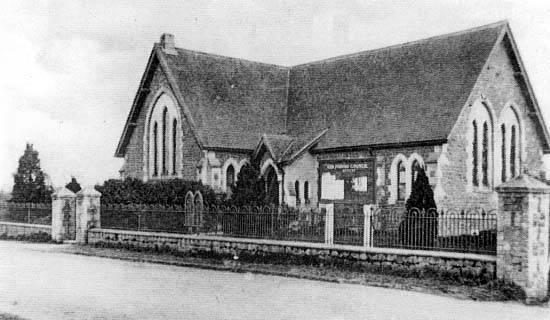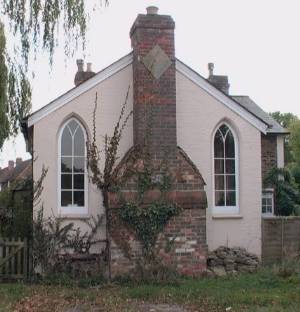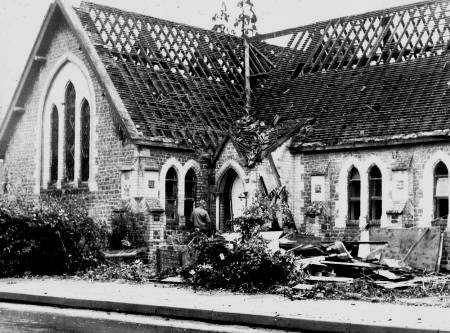
- Wesleyan Methodist Chapel
-
 Wesleyan Methodist Chapel at the crossroads, Normandy c1910
Wesleyan Methodist Chapel at the crossroads, Normandy c1910
When James Horne and his family returned to Normandy in about 1822, they
lived in the Flexford area, later moving to Normandy Hill Farm leased from
the Reverend William Parsons. Their home was always available for Sunday
school and prayer meetings. Although he had to work long and hard both as
a farmer and schoolteacher to support a growing family, he travelled many
miles often walking, seeking ways and places to establish his faith and
preaching Methodism whenever possible, usually in private dwellings. In
1850 he built a chapel and a pair of small houses in Glaziers Lane, one
of which is now called The Croft and it was in that chapel that he conducted
services, preaching with the vigour and zeal that was his hallmark. Since
he was a schoolteacher it would be reasonable to presume that he established
also a schoolroom in the chapel. The 1851 census shows the chapel as having
had "60 free sittings and 30 other sittings". Richard Chapman
a Wesleyan Minister from Guildford signed the afternoon service on the day
of the census. Although he held the office of Circuit Steward, James preferred
to preach rather than administer. In 1853 "land together with chapel
therein lately erected" was conveyed by James to the Methodists,
and used by them until 1886.

- The Croft, Glaziers Lane, built 1850
When John Parrott brought his family to Normandy from Buckinghamshire
in 1862 he purchased the Normandy Manor Estate, including Normandy Hill
Farm, and his family became close friends of the Hornes. In 1871 his two
sons William and John witnessed the Last Will and Testament of James Horne,
who by then was living, with his wife and daughter Elizabeth at Mariners,
Guildford Road. James' two sons, James and Joseph and their respective families
were living nearby, presumably in the two cottages adjoining the chapel
in Glaziers Lane.
- The two brothers, William and John Parrott, played an important part
in the Methodist movement in Normandy. Minute books of the Quarterly Surrey
and North Hants Mission Circuit show that they both preached in the area
and opened their home at what is now the Manor House for Circuit Meetings.
The minutes also show that in April 1861 James Horne's son Jabez, born
1837, preached his Trial Sermon and was recommended to be a local preacher.
About this time the Methodists purchased from the Parrotts two pieces of
land near the crossroads. The larger for £45 and the adjoining strip
to the west for £6.10s.0d and on the site, in 1886, built the large
chapel in Gothic style consisting of two halls, one for services and the
other for social functions. The old and small chapel of 1850 became defunct,
but in the early 1900s was used as an evening institute for teaching shoe
repairs and cookery. By 1898, when the Parrotts left the area, the new
chapel had a flourishing congregation.
Some referred to the building as a church others as a chapel. Even in
communal conversation, a group would quite happily mix the two names. John
Wesley never wished the Methodists to leave the Church of England. The definite
break, however, came in 1795, four years after his death. The followers
were known as the Wesleyan Methodist Church, later breaking into various
smaller schisms only to rejoin again starting in the early 1900s.
- The chapel at Willey Green was not registered for marriages until 1964
and the building was too small in any case to hold anything but a very
modest wedding function. Chapel worshippers were invited, therefore, to
have their wedding and reception in the larger Methodist Wesleyan Chapel
at the crossroads. Rosie Coleman, the daughter of Ernie Coleman, the Superintendent
of the Congregational Chapel married Eric Privitt in this chapel in October
1935 as did their very good friends William and Catherine Fooks in July
1938 but on that occasion their own Congregational Minister, the Reverend
Davis, performed the service. Cyril and Doris Prangnell, although married
in 1940 at St. Mark's Church, also held their wedding reception in this
chapel.
-
- The 1950s witnessed the start of a dwindling congregation. A visiting
preacher, John Newland, recalls taking the regular service, of four hymns
and a full sermon, to a congregation of just four children. It is believed
that Gladys Marshall and Alfred Williams last used the chapel for worship.
In 1953 the Chapel was de-consecrated and the building was sold to C J
Williams when it was converted and used as a drawing office by architects
until 1965. The building proved too difficult to maintain, it became derelict,
infested with vermin and was eventually demolished in 1970. There was no
great uproar when the building was demolished and the wooden pews burnt,
and only after the disappearance of the chapel as a landmark, was its passing
regretted.
-

- Wesleyan Methodist Chapel - being demolished in 1970
From 1953, until demolition in 1970 by Messrs. Channings of Guildford,
the Chapel had a trail of planning applications for re-use as industrial
premises, re-development into shops with flats over and simple residential
housing. Today the site (less that conveyed to the Surrey County Council
for a bus lay-by), is occupied by a pair of semi-detached houses; Chelsford
and Moelfre built by Thomas McAllister (a local property developer), then
trading as Thomas Alfred Ltd.
*******
- Congregational Ministers
- 1921 - 1924
1924 - 1927
1929 - 1936
1937 - 1938
1939 - 1946
1946 - 1949
1951 - 1960
1960 - 1967
1967 - 1987
1989
|
Reverend F Hosier
Reverend AW Austin
Reverend Arthur Lewis
Reverend A Hitchcock
Pastor GW Simmons
Reverend Arthur Bowen
Reverend DS Bell
Reverend Alan Cassingham
Reverend Derek Wensley
Reverend Ray Whittle
Reverend David Bedford |
 Download the list of Congregational Ministers
Download the list of Congregational Ministers
 "The
Church in the Wilderness" (Memorials of James Horne) "The
Church in the Wilderness" (Memorials of James Horne)
 "The
Church in the Wilderness" (as PDF file) "The
Church in the Wilderness" (as PDF file)

 Back to Places of Worship Back to Places of Worship
 Back to Index Back to Index
-
- © Copyright by Normandy
Historians All Rights Reserved.
|

 Wesleyan Methodist Chapel at the crossroads, Normandy c1910
Wesleyan Methodist Chapel at the crossroads, Normandy c1910
